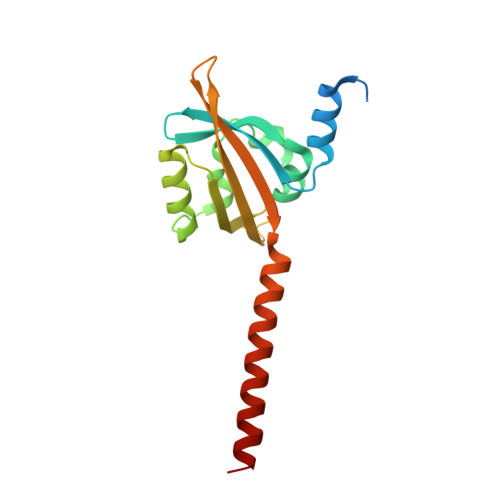Structural determinants underlying the adduct lifetime in the LOV proteins of Pseudomonas putida.
Arinkin, V., Granzin, J., Krauss, U., Jaeger, K.E., Willbold, D., Batra-Safferling, R.(2021) FEBS J 288: 4955-4972
- PubMed: 33621443
- DOI: https://doi.org/10.1111/febs.15785
- Primary Citation of Related Structures:
7A6P - PubMed Abstract:
The primary photochemistry is similar among the flavin-bound sensory domains of light-oxygen-voltage (LOV) photoreceptors, where upon blue-light illumination a covalent adduct is formed on the microseconds time scale between the flavin chromophore and a strictly conserved cysteine residue. In contrast, the adduct-state decay kinetics vary from seconds to days or longer. The molecular basis for this variation among structurally conserved LOV domains is not fully understood. Here, we selected PpSB2-LOV, a fast-cycling (τ rec 3.5 min, 20 °C) short LOV protein from Pseudomonas putida that shares 67% sequence identity with a slow-cycling (τ rec 2467 min, 20 °C) homologous protein PpSB1-LOV. Based on the crystal structure of the PpSB2-LOV in the dark state reported here, we used a comparative approach, in which we combined structure and sequence information with molecular dynamic (MD) simulations to address the mechanistic basis for the vastly different adduct-state lifetimes in the two homologous proteins. MD simulations pointed toward dynamically distinct structural region, which were subsequently targeted by site-directed mutagenesis of PpSB2-LOV, where we introduced single- and multisite substitutions exchanging them with the corresponding residues from PpSB1-LOV. Collectively, the data presented identify key amino acids on the Aβ-Bβ, Eα-Fα loops, and the Fα helix, such as E27 and I66, that play a decisive role in determining the adduct lifetime. Our results additionally suggest a correlation between the solvent accessibility of the chromophore pocket and adduct-state lifetime. The presented results add to our understanding of LOV signaling and will have important implications in tuning the signaling behavior (on/off kinetics) of LOV-based optogenetic tools.
- IBI-7: Structural Biochemistry, Forschungszentrum Jülich, Germany.
Organizational Affiliation:


















